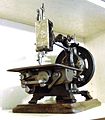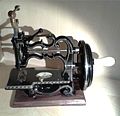User:Panjigally/Antique and Vintage Sewing Machines
| This is not a Wikipedia article: It is an individual user's work-in-progress page, and may be incomplete and/or unreliable. For guidance on developing this draft, see Wikipedia:So you made a userspace draft. Find sources: Google (books · news · scholar · free images · WP refs) · FENS · JSTOR · TWL |
Collecting Antique and Vintage Sewing Machines.
[edit]An antique sewing machine can be regarded as one that is rare, in good condition and manufactured at least 100 years ago. However, there are many machines that are older than this but are still so common that they are not properly regarded as antiques. A vintage machine may be younger than this, perhaps produces as late as the 1960's. These are still sometimes valued and collected due to their rarity and unique design.
Mid to Late Victorian Machines
[edit]A sewing machine has to be rigid and reproducible. Therefore, despite the great weight, most early models were of cast iron drilled to accept steel fittings for the moving parts. It was an easy step to adapt ironwork factories for the mass production of sewing machines.
With a few exceptions there were two main systems: a twisted chain stitch using the James Edward Allen Gibbs rotating hook and a lock stitch using a boat shaped shuttle or Allen B. Wilson's rotating hook. In addition there was always some way of moving the needle vertically through the fabric and a method of advanceing the material after each stitch. With minor variations in the chosen mechanics and manufacturers would apply their own ornamentation to the shape of the casings and add varying degrees of surface decoration. Sometimes this was all that separated one machine from another. Between 1865 and the end of the century sewing machines became an eye catching, practical additions to the home displaying all the flamboyance of the late Victorians.
-
Avon Sewing Machine (UK).
-
A rare White Gem (USA).
-
A Raymond-Weir (Canada).
-
A Johnson Clarke Home Shuttle (USA).
The turn of the century
[edit]The patent thicket which led to the Sewing Machine Combination (1856 to 1877) allowed manufacturers to use the best ideas for each task the sewing machine had to perform. By the turn of the century improved iron casting techniques led to a common design utilising the most efficient and reliable patents so that many machines displayed the overall look that we associate with the modern device. They were very robust and millions have survived so that, despite their age, they carry little aesthetic or monetary value unless they are in mint condition or have some unusual characteristics appreciated by enthusiasts.
-
A German Gritzner Number 1 sewing machine from about 1930.
-
A German design Frister & Rossmann sewing machine from about 1920.
-
Stoewer Sewing Machine from about 1910.
-
Collier No3 Sewing Machine imported to the UK and re-badged - from about 1930
Some later models...
-
A Singer 66 with the Lotus design.
-
Singer 99 in very good condition.
-
A Singer 222k Featherweight, a vintage alloy machine from 1954.
Of these three only the Featherweight can be regarded as vintage.
Collecting
[edit]Most collectors prefer the very early machines for display but there are a growing number who still use vintage models from the first half of the 20th century. The singer 66, 99 and Featherwieght are amongst these.
Collections
[edit]http://www.sewalot.com/sewing_machine_collection.htm
The Warren Collection at http://teahippo.uk/antiquesewingmachines/
The sewmuse virtual collection http://www.sewmuse.co.uk/
The Hopkirk Museum https://www.hobkirk.co.uk/hobkirks-sewing-machine-museum
The London Sewing Machine Collection http://www.craftysewer.com/acatalog/wimsew_catalog_Views_of_the_Museum_341.html
References
[edit]External links
[edit]












